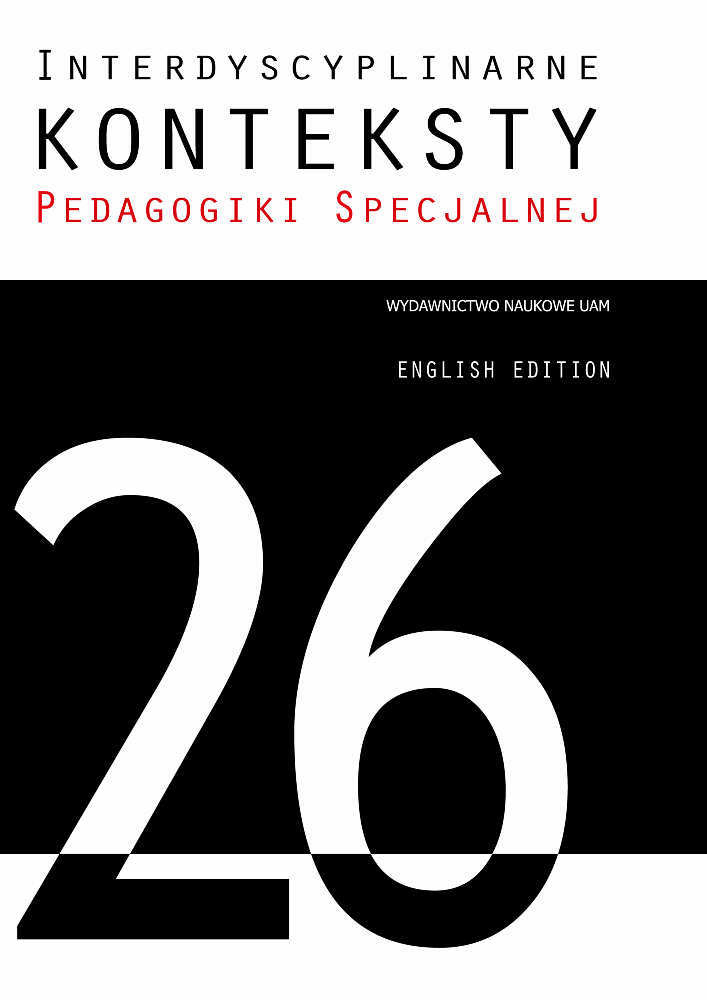Abstract
Anida Szafrańska, Support Teachers in the Education of Students with Autism and Asperger Syndrome in Integrated and Mainstream Schools. Interdisciplinary Contexts of Special Pedagogy, no. 26, Poznań 2019. Pp. 59–80. Adam Mickiewicz University Press. ISSN 2300-391X. e-ISSN 2658-283X. DOI: https://doi.org/10.14746/ikps.2019.26.03
The article presents a pilot study of the tasks of support teachers in relation to students with autism, including those with Asperger’s syndrome. Data contained in the Educational Information System shows a significant increase in the number of students with this type of disorder studying in integrated units and mainstream schools. The education of students with autism and Asperger’s syndrome is difficult due to their deficits in the cognitive sphere, as well as problems in social and emotional functioning. When carried out in an appropriate manner, with relevant professional
support, the inclusion of autistic children may be beneficial both for the children’s intellectual, social and emotional development, as well as other students.
References
Boujut E., Dean A., Grouselle A., Cappe E., Comparative Study of Teachers in Regular Schools and Teachers in Specialized Schools in France, Working with Students with an Autism Spectrum Disorder: Stress, Social Support, Coping Strategies and Burnout, J Autism Dev Disord (2016) 46.
Chrzanowska I., Wstęp, „Interdyscyplinarne Konteksty Pedagogiki Specjalnej”, 2013, No. 1.
Chrzanowska I., Pedagogika specjalna. Od tradycji do współczesności, Oficyna Wydawnicza „Impuls”, Kraków 2015.
Chrzanowska I., Wiedza na temat autyzmu wśród obecnych i przyszłych pedagogów a dylemat wspólnego kształcenia i integracji w wymiarze edukacyjnym, „Rocznik Lubuski” 2012, Vol. 38, part 2, p. 112 (pp. 105–114).
Evans J., Lunt I., Inclusive education: are there limits? “European Journal of Special Need Education”, 2002, 17(1), pp. 1–14.
Firkowska-Mankiewicz A., Szumski G., Pedagogika specjalna i system kształcenia osób z niepełnosprawnościami w Polsce, [in:] Pedagogika specjalna 2. Podręcznik akademicki, D. D. Smith, Wydawnictwo PWN, Warszawa 2009.
Gałecki P., Święcicki Ł. (academic supervision, Polish ed.) Kryteria diagnostyczne z DSM 5: Desk Reference, Wydawnictwo Edra Urban & Partner. Wrocław 2015.
Głodkowska J., W poszukiwaniu modelu edukacji włączającej, „Meritum”, 2009, No. 2(13).
Grzelak P., Kubicki P., Orłowska M., Realizacja badania ścieżek edukacyjnych niepełnosprawnych dzieci, uczniów i absolwentów. Raport końcowy, Educational Research Institute in Warsaw 2014.
Janiszewska-Nieścioruk Z., (Nie)dojrzałość proinkluzyjnych zmian w kształceniu osób z niepełnosprawnością, „Niepełnosprawność. Dyskursy pedagogiki specjalnej”, 2016, No. 22, pp. 47–59.
Klin A., Typologia zaburzeń ze spektrum. Aspekty teoretyczne, badawcze i kliniczne, [in:] Diagnoza zaburzeń ze spektrum autyzmu, ed. S. Goldstein, Jack A. Naglieri, S. Ozonoff, Wydawnictwo Uniwersytetu Jagiellońskiego, Kraków 2017.
Klinger L.G., O’Kelly S.E., Mussey J.L., Diagnoza funkcjonowania intelektualnego w zaburzeniach ze spektrum autyzmu, [in:] Diagnoza zaburzeń ze spektrum autyzmu, ed. S. Goldstein, Jack A. Naglieri, S. Ozonoff, Wydawnictwo Uniwersytetu Jagiellońskiego, Kraków 2017.
Międzynarodowa Statystyczna Klasyfikacja Chorób i problemów Zdrowotnych. Rewizja 10 (International Statistical Classification of Diseases and Health Problems. Revision 10), WHO 2008, p. 248.
Nason B., Porozmawiajmy o autyzmie. Przewodnik dla rodziców i specjalistów, Wydawnictwo Uniwersytetu Jagiellońskiego, Kraków 2017.
Płatos M. (ed.), Ogólnopolski spis autyzmu. Sytuacja młodzieży i dorosłych z autyzmem w Polsce, Wydawca Innowacji Społecznych „Mary i Max”, Warszawa 2016.
Olszewski S., Parys K., Rozumieć chaos. Rzecz o terminach i znaczeniach im nadawanych w pedagogice specjalnej, Wydawnictwo Naukowe Uniwersytetu Pedagogicznego in Kraków, Kraków 2016.
Rybakowski F., Białek A., Chojnicka I. et al., Zaburzenia ze spektrum autyzmu – epidemiologia, objawy, współzachorowalność i rozpoznawanie, „Psychiatria Polska” 2014, 48(4), pp. 653–665.
Rosenberg R.E., Kaufmann W.E., Law J.K., Law P.A., Parent Report of Community Psychiatric Comorbid Diagnoses in Autism Spectrum Disorders, “Autism Research and Treatment”, 2011 Aug. 18
<https://www.ncbi.nlm.nih.gov/pmc/articles/PMC3420588/> [access: 8 February 2018].
Regulation of the Minister of National Education of 9 August 2017 on the conditions for organising education, upbringing and care for children and youth with disabilities, socially maladjusted and at risk of social maladjustment § 7 section 7 and § 5 section 4 (Journal of Laws of 2017, item 1578).
Regulation of the Minister of National Education of 7 September 2017 on opinions and decisions issued by adjudicating panels operating in public psychological and pedagogical counselling centres; Journal of Laws of 2017, item 1743.
Sansosti J. M., Sansosti F., Inclusion for Students with High-functioning Autism Spectrum Disorders: Definitions and Decision Making Psychology in the Schools, 2012, Vol. 49(10), pp. 917–931.
Act of 14 December 2016 Education Law (Journal of Laws of 2017, item 59).
<https://www.nadzor-pedagogiczny.pl/porada/jakie-kwalifikacje-musi-posiadac-nauczyciel-wspoma/9285/> [access: 29 May 2019].
